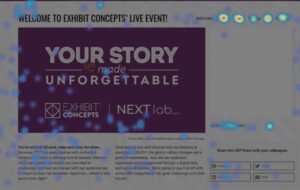With face-to-face at a standstill and many marketing teams turning to virtual and digital events to reach out to customers and prospects, there are a lot of questions about what metrics and analytics are appropriate in a virtual world and how they are determined.
The answer, not surprisingly, is not all that different than what applies to an in-person event…it depends on your objectives of exhibiting at a trade show; product launch, brand awareness, relationship nurturing, etc.
While the ultimate goals are sales and revenue, it is important to remember that there are many other factors that go into whether a prospect buys your product: price, features, competitor offerings, salesperson’s responsiveness and skill, among others. Therefore, you want to make sure you are capturing and evaluating the effectiveness of your event based on those more controllable factors in addition to and in some cases, instead of sales generated because of your event.
Registrations
In a trade show situation, driving attendance is largely the responsibility of the show organizer – audience targeting, event theming, attractive and accessible venue, speakers and tracks, expo hall, entertainment, and of course price. There are many opportunities for exhibitors to drive traffic to their booth or special event by supplementing the efforts of the show organizer with different sponsorship opportunities and pre-show mailers. Your booth is your billboard in the show hall and engagement activities serve to draw in an audience as well as convey your message.
With an independent virtual event, driving attendance is on the marketer’s shoulders. Registrations, the number of unique requests to attend your event, are the first measure of the success of your targeting, messaging, event strategy and value. Understanding conversion rate of your registration page is an important measure of the effectiveness of the page.
- How many people visit your registration page – how effective is your targeting and messaging?
- How many people complete the registration form – how effective is your messaging and page layout?
Attendance
![]()
Attendance measures how many of your registered audience logged onto your digital event. Industry data suggests that on average, 40% – 50% of those registering for a virtual event attend the live event. Don’t be disheartened if initial attendance is low. Registrants have come to expect that the event content will be made available after the live event. There is a great deal of insight that can be gleaned from attendance metrics:
- What time did registrants start logging on – what pre-show information should you provide?
- How long after the start were registrants still joining – is there a more opportune time for your event? Should you restrict access after a certain point?
- What percentage of registrants stayed with you from start to finish – how on point and engaging is your event content?
- What is the average time spent watching your content – is the content engaging from start to finish? Do you need to shorten your content?
Don’t forget that not all registrants will be able to attend your event when it is occurring live. Be sure to analyze the above suggested metrics for however long you make the post–event content available. Track live event attendees and post-event attendees separately to see if there are patterns or insights to be gained.
Engagement and Content Consumption
The most critical considerations about how effective your event is will be found in the metrics you collect and analyze about engagement. This is the primary reason you are hosting a virtual event in the first place. Completion time and average time of watched content are a few measurements mentioned in the Attendance section. Evaluating the different components of your event and the impact each made on the event’s analytics will validate their purpose. The metrics here evaluate your event content but also site layout.
- Heat mapping – what content are attendees exploring? Is there content they don’t explore? If so, do you need to include that in future events? Is the most important content driving the most clicks?

- Polling participation – what percent of attendees complete the polls? Are there conclusions to be gleaned from poll responses? Can you connect poll responses to registrations to supply more intel to your sales team?
- Chat or Q&A participation – are attendees participating? Are there common questions that should be incorporated in the main content in your next event?
- Extra Resources – what additional content are attendees exploring?
- Entertainment – are attendees taking advantage of the fun activities you’ve included? How many selfies were submitted?
Actions
For most events, this is what you would consider the “payoff”. Did the attendee take the intended action? Did they submit a best practice? Did they request a meeting? Measurements here are tied directly back to your original goals.
- If your goal is to set appointments for your sales team with qualified prospects, you’ll want to capture how many attendees request or schedule a follow up meeting.
- Likewise, if your goal is to advance the sales process by delivering specific content and messages, you’ll want to evaluate how many people downloaded a specific piece of content or completed a qualifying questionnaire.
- If your goal is to educate your audience about your brand’s unique features, you’ll want to evaluate the pre- and post-event knowledge of your audience about your content.
- If you are using the event for market research or to gather information for marketing content, you’ll want to measure form submissions and engagements.
Goal Setting
While the S.M.A.R.T acronym is most associated with establishing performance objectives for employees, it can also be applied to goal setting for any marketing program, campaign or activity.
- S – Specific. Set specific goals. For example, if your goal is to book meetings for the sales team, spell out exactly how many meetings you intend to set.
- M-Measurable. This is about articulating exactly how you will measure and evaluate the results. Using meetings as an example, have you included a meeting scheduler in your event? If a salesperson follows up with an attendee after the event and they agree to a meeting, does that count?
- A-Attainable or Achievable. Is the goal within the scope of your event?
- R-Realistic. Given the resources you are putting into this event, are your goals realistic? Another consideration is using past performance of similar events as a comparison.
- T-Time-bound. What time period are you going to use to measure the success of your event?
An added consideration when setting goals is to work backwards from your ultimate goal to set milestones along the way.
- What are your joint sales and marketing goals?
For example, sell 10 new widgets in Q1. - How many of those sales are from marketing sourced leads?
For example, 60% or 6. - What percent of marketing sourced leads are from this event?
For example, 50% or 3. - What is your company’s win conversion rate from opportunities to wins?
For example, 25%; therefore, in order to achieve 3 wins, you need to have 12 proposals submitted to prospects. - How many demonstrations or capabilities review meetings result in requests for proposal?
For example, 20%; therefore, in order to have 12 RFPs, you need to have 60 meetings. - How many contacts that hear “elevator pitch” request a meeting?
For example, 10%; therefore, you need 600 people to hear your pitch. That 600 equates to how many people you are targeting to attend your event and listen to your content.
For those marketers new to virtual and digital events, planning the event itself can be an intimidating experience, let alone evaluating the success of the event. However, if you start with the end in mind you have a much better chance of success.









